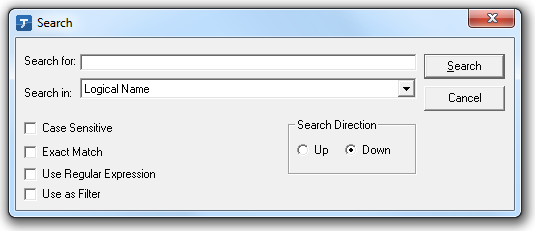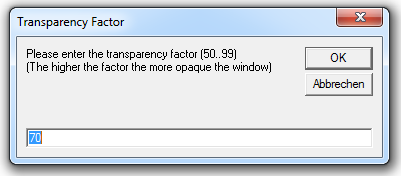The Tosca Wizard menu bar is dynamically structured and its contents are available to users depending on the context they are working in.
In chapter "Scan classic Modules with Legacy Scan" we show you how to create Modules with Tosca Wizard.
After one page of the test object has been scanned with Tosca Wizard, a connection is established between this page and Tosca Wizard. This connection is terminated if the user navigates to another page. All the information that is already contained in Tosca Wizard can be freely edited and saved.
File menu
|
Option |
Description |
|---|---|
|
Scan DB |
This option allows Modules to be scanned from a database connection (see chapter "DATABASE I Creating Modules"). |
|
Exit |
This closes Tosca Wizard. |

Wizard menu File
Edit menu
After the test object has been successfully scanned, the following options are available for selection:
|
Option |
Description |
Key combination |
|---|---|---|
|
Rename |
This option renames all items that are selected in the tree view. |
|
|
Copy |
This copies both the property and its value range selected in the Control Properties tab to the clipboard (see "Copying controls in XML format"). |
Ctrl + C |
|
Unselect All |
Deselects all selected items in the tree |
|
|
Select All |
Select all items in the tree |
|
|
Expand All |
Expands all nodes in the tree view |
|
|
Collapse All |
Collapses all nodes in the tree view |
|
|
Search |
This option opens a search dialog (see "Searching for objects"). |
Ctrl + F |
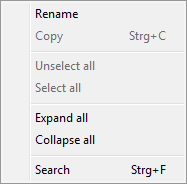
Wizard menu Edit
Copying controls in XML format
Tosca Wizard allows the XML code of individual controls to be read out via the option Copy.
A property must therefore be selected in the Control Properties tab. The name and the value range of this property are copied to the Windows clipboard. Alternatively you can also perform a double-click (see also chapter "Copying values to the clipboard")
Example: innerHTML property
.innerHTML=<tbody>
<tr><td style="white-space: nowrap;" dir="ltr" id="gs_ttc0"></td>
<td id="gs_tti0" class="gsib_a"><div style="position: relative;" id="gs_lc0"><input style='background: url("data:image/gif;base64,R0lGODlhAQABAID/AMDAwAAAACH5BAEAAAAALAAAAAABAAEAAAICRAEAO
A search dialog opens if the option Search is selected.
You can search for logical names, technical descriptions, or both.
The following options can be enabled by selecting the corresponding checkbox:
-
Case Sensitive
The search is case-sensitive.
-
Exact Match
The exact match is searched.
-
Use Regular Expression
Regular expressions are used in the search query.
Example: [0-9]$
The first item that ends with a cipher is searched.
-
Use as Filter
The specified search criteria are used as a filter in Tosca Wizard. Only items that match these criteria are displayed.
Project menu
|
Option |
Description |
|---|---|
|
Edit Settings... |
This opens the Settings dialog in order to edit the settings for Tosca Wizard (see chapter "Settings - Wizard"). |

Wizard menu Project
View menu
|
Option |
Description |
Key combination |
|---|---|---|
|
Transparent->Transparent look |
The window is displayed transparently. |
Ctrl + T |
|
Transparent->Transparent during move |
The window is made transparent for the time it is being positioned. |
Ctrl + M |
|
Transparent->Transparency factor... |
This allows the transparency level of the window to be adjusted (see chapter "Defining the transparency factor"). |
|
|
Hide window during scan process |
The Tosca Wizard window is minimized upon scanning. |
|
|
Show application info |
Additional information on the test object is shown in this window (see Illustration "Show application info"). |
|
|
Show only selected items |
This option restricts the number of displayed items in the tree to the items that are selected. |
|
|
Current filter: <none> |
The number of object types to be displayed in the tree can be restricted by using filters (see chapter "Filtering control types"). |

Wizard menu View
Each detected object can be assigned to a specific control type.
The option Current Filter: <none> enables you to restrict the number of scan results to one or more control types.
In the subsequent dialog you can select the required control types by enabling the corresponding checkboxes.
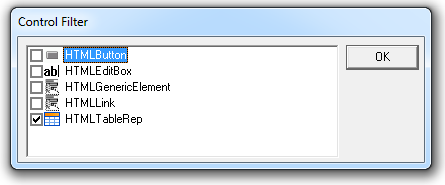
Selecting filters
After you have confirmed your selection with a click on the OK button, Tosca Wizard displays the items of the selected type in the tree:
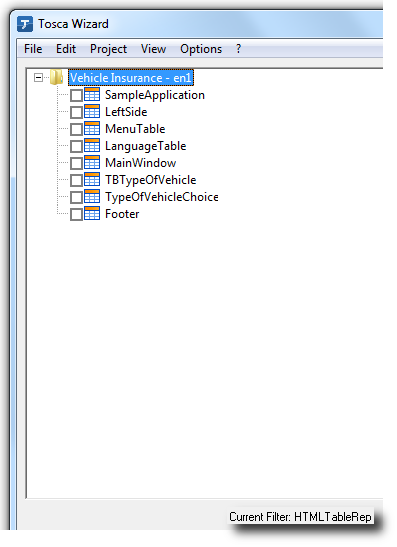
Active filter
The filter that is currently active is shown on the lower right side. If the selected control types are deselected, the filter is reset.
Showing information on the test object
A section which defines one of the following three properties, must be added to the WizardMappings.dat file to be able to scan an application with Tosca Wizard:
Class=...
<name of the executable file>
Caption=...
Tosca Wizard records this information upon scanning (see chapter "Settings in the WizardMappings.dat file").
If the option Show application info is enabled, the information is shown in Tosca Wizard.
Defining the transparency factor
Transparency is specified via the option Transparent->Transparency Factor.... The transparency degree is indicated in percent. The higher the value, the less transparent the window will be displayed. The default value is 70%.
Options menu
|
Option |
Description |
Key combination |
|---|---|---|
|
Mark selected control |
If an object is selected in the tree view, the referenced object is highlighted in red in the test object (see Illustration "Marking controls"). |
|
|
Scanning->Scan all items |
All visible, steerable and even invisible objects are scanned when the test object is being scanned. |
|
|
Scanning->Enable hotkey (F12) |
The test object can be scanned by using hotkeys (see chapter "Scanning applications with hotkey"). The F12 key is set by default. |
Ctrl + H |
|
Scanning->Minimize statusbar |
This option minimizes the Scan Progress window. |
|
|
Use UIAEngine |
The Tosca UIA Engine is used for scanning the application. |
|

Wizard menu Options
Highlighting objects in the application
The option Mark selected control assists you with business-based classification of controls. If an object is selected in the tree in Tosca Wizard, the referenced control is highlighted in red in the application.

|
Whether objects are highlighted in the application or not depends mainly on the used technology and the control type to be highlighted. |
? menu
|
Option |
Description |
Key combination |
|---|---|---|
|
Help |
This opens the documentation for Tricentis Tosca. |
F1 |
|
About |
This option shows both the version and build number, and allows the system info to be accessed. |
|
|
About Engine (optional) |
This menu entry is displayed only after an SAP or DotNet application was scanned. The subsequent dialog shows the version number of the corresponding Tosca Engine. |
|

Wizard Menu ?
